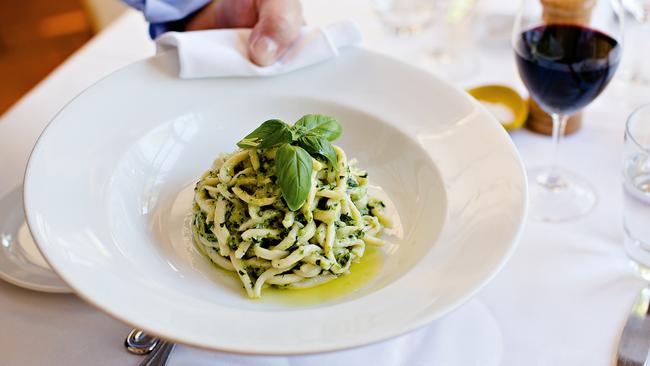Perfect pesto: garlic, basil, cheese, pine nuts, olive oil
Put your hand up if pesto — classic basil and pine-nut pesto — was one of the first things you ever “cooked”.

I woke in a fog. The mobile, fuzzy, dreamlike state following a solid sleep that began only after 5am and ended beyond the second tap on “snooze”. About two hours later. The hours that preceded that blissful surrender? A kind of semiconscious nether-world that kicked in around midnight.
Raw garlic. Raw, homegrown garlic, to be precise, a version of my favourite allium with extra horsepower.
I always think I’ll get away with it but usually don’t: for me, apart from being an almost essential component of anything I put in my mouth bar toothpaste, garlic in its raw form is also a serious stimulant, truly a case of pleasure and pain. And I’d just mainlined too much, a combination of immature zeal.
Why don’t I trust recipes when it comes to anchor notes such as garlic, anchovy, chilli — and rediscovered passion? For pesto.
Put your hand up if pesto — classic basil and pine nut pesto alla Genovese, not your newfangled variations — was one of the first things you ever “cooked”.
I reckon that’s about half Australia’s baby boomers right there, a broad demographic I have trouble identifying with for reasons of vanity and denial but, technically, cannot.
Pesto got spun more times than Culture Club in the 1980s when a lot of people my vintage first dabbled in the kitchen. It was a simple thing that relied on correct procedure, a particular tool and quality ingredients. Oh, and time. Lots of pounding and rotating with a pestle. In a mortar.
Trouble is, the ingredients weren’t always that easy to procure, the procedure was time-consuming and because we hadn’t yet heard of slow food, we all thought electric machines a major progression from the Stone Age. So corners inevitably were cut.
A lot of Australian pesto circa 1985 was made with awful basil, a hard, salty Australian cheese marketed as parmesan (but self-evidently not), tired olive oil, imported garlic and rancid pine nuts. In a food processor.
No wonder the stuff in the jar took off in supermarkets before too long and ended up in packet pasta meals on shelves made in factories owned by multinationals; it was horrible, but marginally better than that garbage-in, garbage-out home version.
The real deal, as I rediscovered recently at a restaurant in Sydney where they made it at the table with beautiful ingredients — by hand — is as good as it always was. Absolutely sublime.
An emulsion of garlic and salt, quality basil, parmigiano reggiano, pecorino, untoasted pine nuts and fruity olive oil. That’s all, but that’s everything.
With firm, decent pasta such as penne or strozzapreti (every Italian will have a view on which is the appropriate shape, but I’m Australian and really don’t have the energy to get hung up on that sort of thing) and a little of the starchy cooking water to loosen the emulsion, it remains just a wonderful, creamy, olfactory blast of a companion to the world’s most essential starch. And it’s so easy.
First, grow some basil. And garlic, which you will hang to dry for a few months. When that’s done, buy yourself a big mortar and pestle set from an Asian grocery where they sell for sensible prices, some quality cheese (two types, parmigiano and pecorino) and pine nuts (did you know we don’t produce pine nuts in this country because of those bloody cockatoos?). Plus, since it’s a fundamental component of the “sauce” and shouldn’t be skimped on, the best and freshest Australian olive oil you can afford. It’s then just a matter of following the procedure. By hand. A processor is acceptable but will produce an unwanted bitterness when what you really want is fragrance. Mash the garlic with a little salt, add the basil, then the grated cheeses and pine nuts and, finally, the oil. That’s it.
Google “Lucio’s pesto” and you can save yourself the cost of his book, although I’d argue The Art of Pasta is worth every cent to have it on your shelf.
So why did this staple from my 20s-30s fall out of the repertoire? Too many bad meals with crappy pesto added to everything from quiche to salads? Busy years with a young family when convenience ruled? Or too many bad nights following an excess of raw garlic?
I suspect it was the latter.
I found this online: “If you have low-grade headache or attention-deficit disorder then take off garlic from your meals for a minimum two to three weeks to monitor the impact. If you feel the difference after three weeks then consider lowering or eliminating onion and garlic from your diet.” As we all know, there’s a lot of rubbish to be found in the internet.
Make yourself some beautiful pesto, team it with really good pasta and remind yourself of why this stuff went ballistic in the first place all those years ago,
But have it for lunch. Sleep is almost as essential as pasta.
